[Please scroll to the bottom for links and a one year anniversary update, from August 2010.]
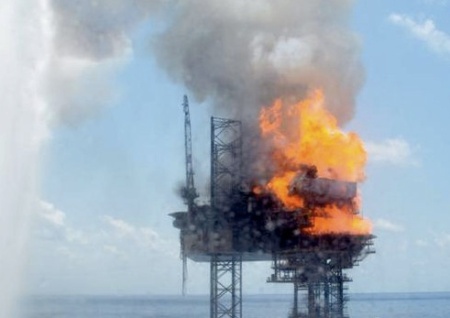
This could very well be the future of Timor Leste’s tasi mane.
I am moved to create this page – albeit way too late – because I believe the Montara/Timor Sea Spill should be causing international outrage. But because it occurred near an unpopulated part of Australia, and one of the poorest parts of Indonesia, little has been said or done for nearly 9 weeks now.
The Timor Sea Spill started on August 21, 2009 when an oil platform in the Australian Montara oil field began spewing crude oil. Montara is located in the Timor Sea approximately 690 km west of Darwin in the Northern Territory and is 250 km northwest of Truscott in Western Australia.
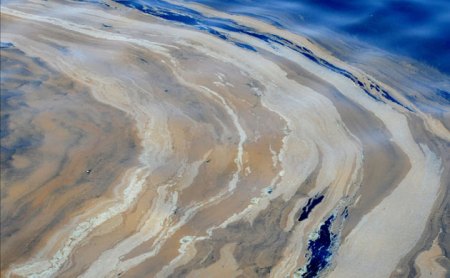
The drilling company claimed that only 300-400 barrels were leaking a day, when in fact the real dimension has only begun to be known 8-9 WEEKS LATER. Reliable Estimates are that it is leaking as many as 2,000 barrels a day.
In late October, a survey released by WWF Australia revealed that the extent of the spill may be greater than the infamous Exxon Valdez spill in Alaska in 1989. (The Valdez was formative in my childhood – my first environmental catastrophe.)
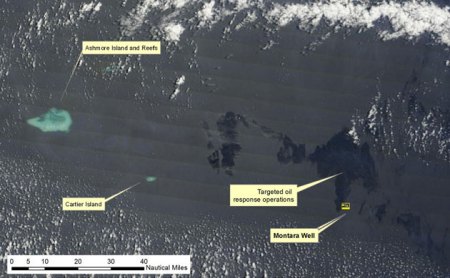
Jakarta has sent teams to NTT to investigate the human and economic impacts of the spill in the Kupang area, where fisherman have complained of oil-related illness, and where a multimillion dollar harvest of seaweed has been destroyed.
The Platform is operated by the Thai Oil Company PTTEP. Ironically, a full month after allowing crude oil to spew into one of the last wilderness areas of northern Australia (September 25), PTTEP bought a $10 million 100% interest in OMV Timor Sea Pty Ltd, a company with licenses to drill in the “Audacious” and “Tenacious” fields.
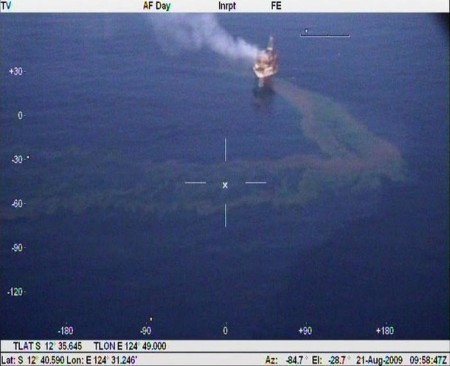
Where is the outrage?
(If Australia wants to redraw maritime boundaries, then shouldn’t it least deal with the greater responsibilities? Why does the Australian Marine Oil Spill Centre site have NO updates since 2002?)
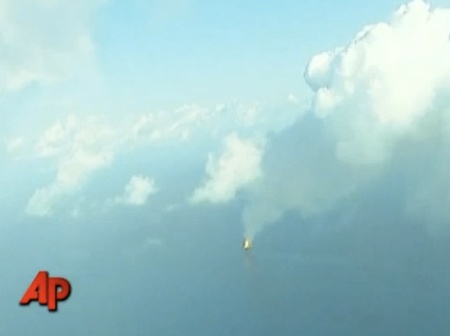
It just so happens that the Thai Ministry of Finance is majority shareholder in PTT Public Company Ltd, the majority shareholder company of PTTEP – meaning the Thai Government, in my view, holds some responsibility for the devastation in the Timor Sea. (And perhaps this makes the issue even more thorny for the Australian government.)
31/10 Update
The public’s “discovery” of another leak in the Timor Sea, this time at Liquefied Natural Gas (LNG) rig 50km from Montara has led to increased public outrage in Australia. The Sinopec Operation at the Puffin Field, we learn, was suspended in May due to “breaches related to serious matters of occupational health, safety and the environment” by the company Sea Production, whose fleet of ships were collecting the LNG for Sinopec.
(Interestingly, Sea Production’s crew in the Timor Sea saved 34 asylum seekers from sure death near Ashmore reef in May 2009. There is surely a whole other soap opera unfolding in the Puffin Field.)
Another interesting development (or non-development) is the utter lack of interest by Indonesian media and blogosphere for the devastating consequences in West Timor. (East Timor watchers will be perhaps amused by the byline of this blog entry “NTT Neglected Province“, none other than Florencio Mario Vieira, a pro-autonomy spokesman.)
I have noticed that Australian campaigners have strategically attempted to “rebrand” the spill as the Kimberly Spill. I suppose nobody will care if the spill remains a “Timor” spill. Another interesting idea has been to render the oil spill next to major Australian cities, like Perth. (Can somebody with Photoshop make one for East Timor?)
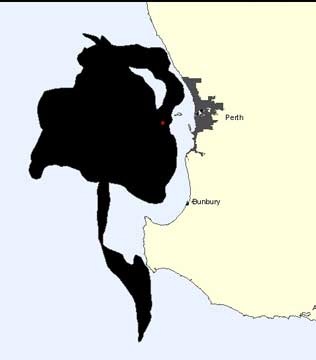
Campaigners have FINALLY started to take public action, such as this Flash Mob in Perth on Friday, October 30th (see video below).
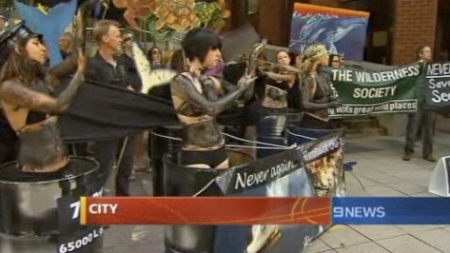
I have added new links below, including NASA images, potential impacts on blue fin tuna breeding, and new stories from Indonesia.
2/11 Update
As you have probably seen in the world’s media, the Montara Oil Rig caught fire during the fourth attempt to plug the well in the ocean beneath. The fire will rage unabated until the well is fully closed off.
The smoke plume is visible from space, and I can only imagine the amount of carbon being released into the atmosphere now. I do not assume that the fire means that the oil leakage has fully stopped.
Spill News continues to be the best source of technical information about the operation to plug the well.
4/11 Update
So, the fire is out. And apparently the well has been plugged. Check out PTTEP’s own photos of the wrecked West Atlas Oil Rig (warning: big file).
Now it is time to fully assess the environmental damage of the spill, for the Australian government to investigate its own response, and for Indonesia to figure out how to help the seaweed growers and fisherman whose livelihoods have been affected.
Meanwhile, independent weekly Tempo Semanal in East Timor questioned the President and Prime Minister about a hypothetical spill affecting their country. The men were quite jovial, considering the amount of damage done to the ocean. In fact they said if it does not affect Timor Leste they “wash their hands” of it. They were strong in saying that had the oil drifted into East Timorese waters, they would have demanded compensation. However, what they did not explain is: what kind of legal framework, regulation of the industry and environmental protection, is there in place for such an event in East Timorese waters?
26/1/2010 Update
The Australian Parliament has launched an inquiry into the Montara Oil Spill. We have already learned that the well was not capped after maintenance, and a day after the “spill” began. The Inquiry’s website is a good resource. Public hearings will apparently take place in late February or early March.
So far, the Inquiry has received a number of interesting submissions, including an oil industry insider who anonymously states:
The petroleum industry in general is rather slow to adopt any new or non-standard technology, even if there are considerable benefits. Most such work is contracted via service companies who are paid a daily rate.
These service companies have no incentive to adopt methods which may reduce the number of days for which they will be paid. They will stick with the “tried and true” methods.
I believe it is appropriate for your commission to ensure that in any future incidents all contractors involved have a financial incentive for the problem to be quickly resolved.
Meanwhile, the contractor fire fighters state:
This is a risk associated with the petro-chemical industry and ‘a fact of life’
*** 1 year after update 21/8/2010 ***
The West Timor Care Foundation has made a public statement condemning both the company and rejecting the Indonesian government’s acceptance of a compensation package. The Foundation believes that the Australian Federal Government is ultimately responsible for dealing with the international dimension of the disaster. Please take a moment and read their statement.
Contacts
- PTTEP sidhichaij@pttep.com; tongchitp@pttep.com
- Green Senator Rachel Siewert
- My Timor Sea Spill Twitter List
The Montara Inquiry
- (New) Inquiry Official site
- (New) Senator Siewert’s Inquiry page
- (New) ‘No cap on Montara Well’
- (New) Sky Truth on the Inquiry (21/1)
Environmental impacts
- (New) Antara: “Waiting for Australia’s good will on Montara Spill”
- E Timorese leaders say they would seek compensation
- SMH: Oil spill death toll rises
- Government’s “Rapid Assessment” of Montara
- AP story on dead fish in Indonesian waters
- Crikey: “Curtains for Bluefin Tuna?”
- ABC News: “Traditional owners horrified”
- WWF’s Montara Spill Report
- Skytruth uses satellite images to question “official” estimates
- Greens questioning of company’s (and government’s) estimates
- Yayasan Peduli Timor Barat press release (Ind)
- NTT Province reports on dead fish and dolphins (Ind)
- Timor Express story on affected seaweed farmers (Ind)
- Kompas story on NTT province efforts to monitor pollution (Ind)
Photos/videos/maps
- (New) Video of pollution in W Timor, Indonesia
- Satellite image of rig fire’s smoke plume
- Al Jazeera report on the Montara rig fire
- NASA Earth Observatory photo set
- NASA MODIS Daily images of Timor Sea
- Skytruth shows a methane plume being released (October)
- News coverage of Perth protest (October)
- Guardian slideshow
- WA Today photo gallery
- Skytruth Flickr set
- Map of Greater Sunrise with oil fields indicated
- Al Jazeera interview with WWF Australia (October)
- Video interview with Green Senator Siewert (August)
- Raw video (ABC TV) from WWF mission (September)
- Compilation video of satellite images from Aug/Sept
Pingback: Tasi ida de’it « Return to Rai Ketak
Pingback: Australia’s shame – the Timor Sea oil spill disaster in pictures – The Northern Myth
Pingback: Mega oil spill reaches Indonesian Coast
Pingback: Global Voices Online » Timor Sea Drilling Spill